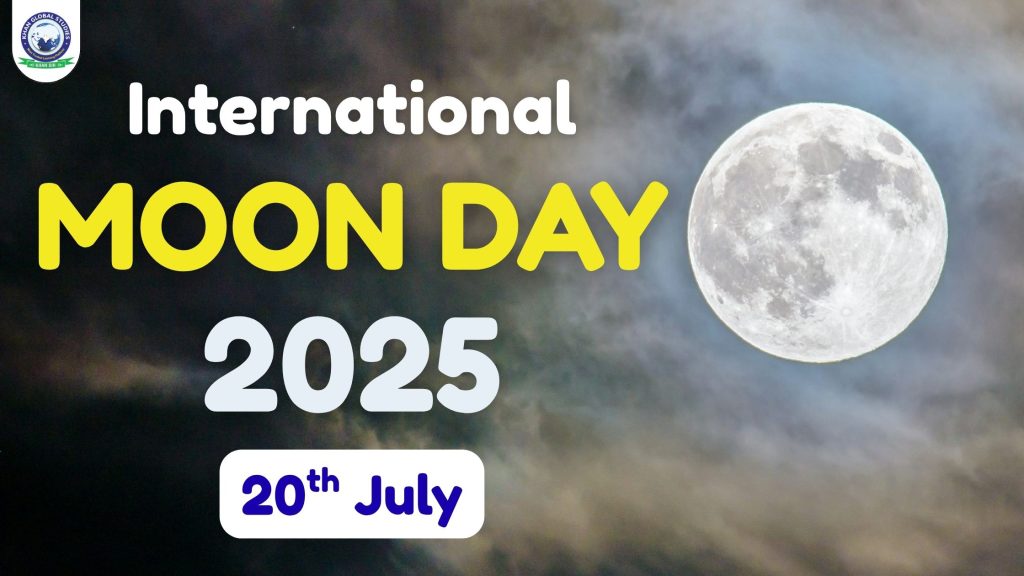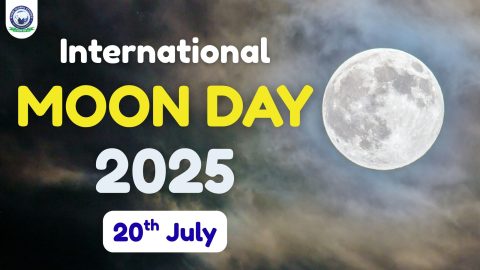International Moon Day is a global celebration that recognises one of the most significant achievements in human history: the landing of Apollo 11 on the Moon. Observed annually on July 20, this day commemorates the moment in 1969 when astronauts Neil Armstrong and Buzz Aldrin took humanity’s first steps on the lunar surface. It is not just a tribute to a historic space mission but also a platform to inspire future generations in the field of space exploration, science, and innovation.
Origin and Significance of International Moon Day
The United Nations General Assembly declared July 20 as International Moon Day in December 2021, under the resolution proposed by the United States and supported by numerous member states. The date marks the anniversary of Apollo 11’s landing, which was the first time humans set foot on another celestial body.
This celebration honors:
- The pioneering efforts of space scientists, engineers, and astronauts.
- International cooperation in the peaceful exploration of outer space.
- The power of human curiosity, innovation, and resilience.
The Apollo 11 Mission: A Giant Leap for Mankind
The Apollo 11 mission, launched by NASA on July 16, 1969, remains one of the greatest milestones in space history. After a four-day journey, on July 20, 1969, the Lunar Module “Eagle” successfully landed on the Moon.
Key Moments:
- Neil Armstrong became the first person to step onto the lunar surface, stating the iconic words: “That’s one small step for man, one giant leap for mankind.”
- Buzz Aldrin followed shortly after, spending over two hours outside the spacecraft.
- The third astronaut, Michael Collins, remained in orbit around the Moon in the Command Module “Columbia.”
The mission demonstrated that with vision, planning, and perseverance, seemingly impossible goals can be achieved. It became a symbol of what humanity can accomplish when united by purpose.
Why We Celebrate International Moon Day?
While the original Moon landing occurred over half a century ago, its impact continues to shape the future. International Moon Day serves several purposes:
1. Education and Awareness
It offers a chance to educate people around the world about:
- The history of space exploration.
- The importance of STEM (Science, Technology, Engineering, and Mathematics) education.
- The ongoing efforts by countries and private agencies to explore the Moon and beyond.
2. Inspiration for Future Generations
By celebrating this day, we spark curiosity in young minds, encouraging them to:
- Dream big
- Pursue careers in science and space
- Contribute to humanity’s ongoing journey through the universe
3. Promoting International Collaboration
The event also emphasizes the importance of peaceful cooperation among nations in the pursuit of space exploration. With several countries now aiming for the Moon — including missions from India, China, Europe, and private space companies — collaboration is key.
International Moon Day Events and Activities
Each year, various educational institutions, space agencies, museums, and science organizations across the globe organize activities to mark International Moon Day. These include:
- Lectures by astronauts and scientists
- Planetarium shows
- Workshops and webinars on lunar science
- Lunar observation nights using telescopes
- Exhibitions on space technology and exploration
- School competitions and quizzes
- Documentary screenings and space-themed art displays
The Moon Village Association (MVA), a key supporter of International Moon Day, coordinates events worldwide and encourages participation across communities.
The Moon Today: Renewed Interest and Exploration
With technological advancements, many nations are now looking at the Moon not just for exploration but also for sustainable human presence and scientific research.
Key Lunar Missions After Apollo 11:
- Artemis Program (NASA): Aims to land the first woman and next man on the Moon and build a sustainable base by the end of the decade.
- Chandrayaan Missions (India): Demonstrates India’s growing capabilities in lunar science.
- Chang’e Missions (China): Advanced robotic exploration and sample return missions.
- Private Sector Involvement: Companies like SpaceX, Blue Origin, and Astrobotic are contributing significantly to lunar logistics and exploration.
Moon Exploration and Sustainable Future
The Moon offers rich scientific opportunities:
- Studying the Moon’s geology helps us understand Earth’s past.
- Establishing lunar bases can support future missions to Mars and beyond.
- It may provide access to resources like water ice, helium-3, and rare minerals.
Through International Moon Day, we underline the potential of space science in solving Earth-based challenges and opening new frontiers for humanity.
How can you celebrate International Moon Day?
Whether you’re a student, teacher, enthusiast, or professional, you can participate in various meaningful ways:
- Host or attend a space science workshop.
- Share lunar facts and historical moments on social media.
- Read books or watch documentaries on the Moon and the Apollo missions.
- Visit a science museum or planetarium.
- Encourage schools to organize space-related activities.
- Join global events listed on the International Moon Day event page.
Even small efforts can lead to greater public understanding and appreciation of space exploration.
Looking Ahead: Our Future with the Moon
The celebration of International Moon Day is not only about honouring the past but also about embracing the future. As we move forward with new lunar missions and international partnerships, the Moon is becoming a gateway to the next era of space exploration.We stand at the brink of a new space age, where our activities on the Moon will pave the way for planetary science, deep space missions, and even interplanetary civilization. The Moon will continue to be a beacon, lighting the way for human ambition, scientific discovery, and peaceful cooperation.





